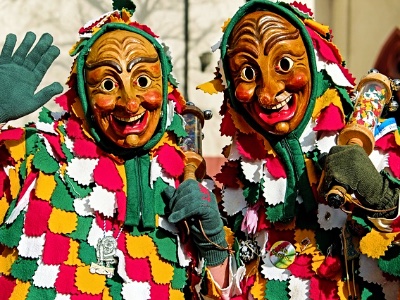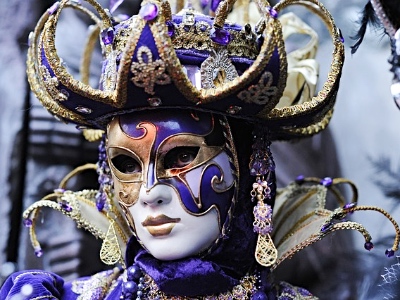If you wander around some German towns and villages at a certain time in February, you may come across people dressed in scary costumes. With their creatively carved wooden masks, they resemble witches, devils or other ugly creatures. But don’t be afraid! When their parades go through the streets, they often throw sweets into the crowd, shout “Narri!” – and the audience responds “Narro!” These parades are part of a centuries-old custom – “Fastnacht”. But to most people it is known by another name: Carnival.
Carnival is a festive season rich in tradition and varies from region to region. Its history is still mysterious in some parts. Where does this custom come from, where people dress up in colourful costumes, and very different rules apply than usual? Let’s go on a journey through the history, customs and settings of carnival.
Traditionally, Carnival is a festive season within Christian culture. It includes street parades and public celebrations – but is certainly not only religious. For many people, it is a faith-neutral, fun time during which the usual role distributions do not apply – at least during the celebrations. Yet, another feature is that carnival is completely different from region to region, and country to country – just like the history of this custom. Nevertheless, the term “Carnival”, has Christian roots – from the Latin “carne levare”, meaning “remove meat”, or perhaps “carne vale”, which means “farewell to meat”. But the origin of this name has not been definitively proven. However, it goes back to the Christian custom of fasting 40 days before Easter, as Jesus is reported in the Bible to have done before his crucifixion. Carnival was then the last extravagant feast before Lent, the last time to enjoy meat or even eggs, milk and butter… But above all, all these highly spoilable fresh products had to be used up before Lent – after all, there were no freezers yet!
But how is it that all these celebrations are so different?
The origins of celebrations during this time of year cannot only be traced back to the Christian season of Lent. In fact, depending on the place, they existed centuries and even thousands of years ago. Among them, for example, in Ancient Egypt, in honour of the goddess Isis, or in Ancient Greece in honour of the god Dionysus – also in Ancient Rome a god was celebrated at this time: Saturn was honoured at the Saturnalia. In other regions, there were traditions, for example, that involved driving away the evil spirits of winter using scary disguises and a lot of noise – for example, as Celtic religious rituals. However, the extent to which these ancient customs evolved and what impact they had on how carnival developed is still not fully clarified. Then, during the later Middle Ages, the actual carnival tradition developed as part of the Christian Lenten season – including an often one-week-long festive period with disguises, dances and games.
No matter how carnival developed, one common thread runs through all variants: all social differences such as different classes or estates, poverty and wealth no longer play a role during Carnival; it is a period of reversed roles, where authority is questioned and seriousness takes a back seat.
Later, during the time of colonization, the tradition was brought to other parts of the world where it was mixed with different celebrations of other cultures. But still, the main similarities stayed the same: parades, dressing up in costumes, dances, plays, eating season-specific food, and everything accompanied by specific music – for example, the “Guggenmusik” in Switzerland. Nevertheless, there are countless unique carnival customs in all the different countries and cultures. Let’s have a look at some of them:

In Germany, carnival is considered as a very important celebration in many regions. The season of carnival is described as the 5th season of the year. Traditionally, also politicians dress up in costumes for some of the celebrations and hold funny speeches. Carnival is also not called “Karneval” everywhere – there are several names for the various celebrations. In Cologne, you celebrate “Karneval”, in Munich it’s “Fasching”, and in Swabia, for example, you call it “Fasnet” or “Fasnacht” – as you can see, carnival plays a big role. The date of carnival also varies: while the season starts on January 6 in some regions, it begins on the 11th November at 11:11 a.m. But that’s also not the start of the actual festivities – they take place from the last Thursday before ash Wednesday (“Schmutziger Donnerstag”) until ash Wednesday where the fasting begins. To experience the main parades, don’t miss Clean Monday (“Rosenmontag”). One very famous carnival celebration is the carnival in Cologne, organized by several committees and including traditional roles such as the “Prince Carnival”. The massive parades with creatively decorated floats featuring satirical figures are watched by up to a million visitors each year. The carnival appears to be very organized, as it features these different traditional figures. This might be a result of its restriction during certain times in history, for example during the Napoleonic era and under Prussian rule. Another tradition is the Swabian-Alemannic Carnival which is inspired by the very old traditions of the Middle Ages. As described above, there are local groups that each have a unique colourful and more or less scary costume – often referring back to an old local tale.

But let’s move on to another place that is famous for its Carnival. In Venice, the Italian city built in the sea, there is a long tradition of very colourful and elaborate (half) masks and costumes. There are artistic performances in the city, the commedia dell’arte form of theatre is performed on stage, and as the highlight the most beautiful costume is rewarded in the costume competition.
In Greece, the Carnival is called Apokries. The city of Patras celebrates this with great parades and dances. And on the island of Skyros, you can find very unique customs, for example the tradition of dressing up as an old man, a shepherd dressed with goat skin and a lot of bells.
Carnival is celebrated in countless other regions in Europe but it also made its way around the globe: In Québec, Canada, “Mardi Gras” is celebrated. In the USA, there are festivities in New Orleans. And you can find Carnival even in India where it was adapted in the state of Goa during the time of colonization by Portugal.
However, one of the most famous Carnival celebrations today is the Carnival of Rio de Janeiro in Brazil, known for its enormous and colourful samba parades.
As you can see, Carnival is a celebration that is rich in tradition, but also shows the variation and uniqueness of all the different cultures where it is celebrated. Still, every form of Carnival has the message to not take it all too seriously, to enjoy life and celebrate. Narri – Narro!
References:
- https://youtu.be/Kp0G0nEQOz4?feature=shared – tagesschau, 28/02/2019
- https://en.wikipedia.org/wiki/Carnival – Wikipedia, accessed 06/09/2023
- https://de.wikipedia.org/wiki/Karneval,_Fastnacht_und_Fasching – Wikipedia, accessed 06/09/2023
- https://www.britannica.com/topic/Carnival-pre-Lent-festival – The Editors of Encyclopaedia Britannica, Encyclopaedia Britannica, 28/08/2023
- https://podcasts.apple.com/de/podcast/alaaf-und-helau-die-geschichte-von-fastnacht-fasching/id1585622346?i=1000600067213 – Terra X History, 17/02/2023
